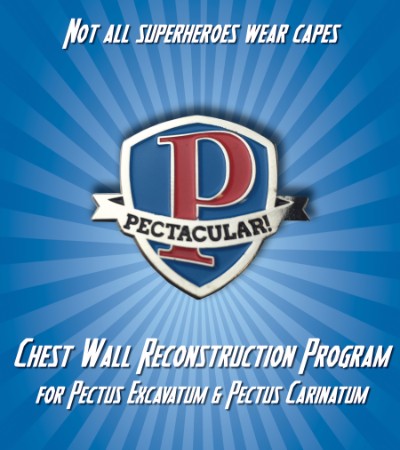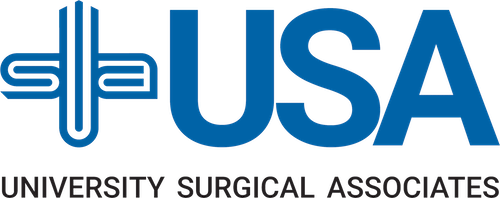Chest Wall Reconstruction
Pectacular!
The Chest Wall Reconstruction Program offered by University Surgical Associates and Children’s Hospital at Erlanger is a multidisciplinary program designed to address the needs of children and their families who were born with pectus excavatum and pectus carinatum. Because the decision to seek treatment is complex and involves the whole family, the program was developed to address those very specific needs, provide support, and connect patients with others who have walked the road they are considering.

Understanding the Condition
Pectus excavatum is a congenital chest wall deformity in which chest cartilage grows abnormally, producing a caved-in or concave appearance in the anterior chest wall. It’s the most common chest wall deformity in children (90% of cases), followed by pectus carinatum (5–7%). Pectus carinatum is thought to occur by the same mechanism, but the chest bows out. Pectus excavatum occurs in an estimated 1 in 300–400 births, and males are more likely to have the condition. The condition generally worsens when rapid growth occurs during the early teenage years. Chest wall deformities can be coupled with problems with self-esteem and body image perception in addition to having physiologic consequences.
A Collaborative Effort
The decision to have surgery to correct pectus excavatum or carinatum is a difficult one. Fortunately, a large team of professionals work together to consistently make improvements in the methods used to treat these conditions and the recovery process for patients. Frequent and routine discussion between the surgeon, nurse practitioners, nurses, physical therapist and anesthesiologists — all who are focused on providing the most advanced care and efficient recovery possible — are the keys to the success of USA’s chest wall reconstruction program. They’ve identified the areas where problems can occur and ways to keep them at bay.
The results of this team-based approach have been dramatic. The benefits include decreased post operative complications and improved pain control after surgery. It’s also resulted in an enhanced recovery process and happy patients and families.
Support from Every Side
Helping children and families through chest wall reconstruction is a team effort. If you choose the Chest Wall Reconstruction Program at USA and Erlanger, it’s more than just surgery. There’s pre-surgery educational sessions and pre-hab (a process that prepares the body through breathing exercises and strengthening key muscles). Also present are pain management specialists and a network of resource families who are there to answer every question and provide answers – because they’ve been through it themselves.
The team, led by Lisa A. Smith, MD, a pediatric surgeon who specializes in chest wall reconstruction, also includes the University Surgical Associates’ office staff (nurses, financial counselors, schedulers), anesthesiologists and anesthesia nurse specialists, physical therapists (in and out of the hospital), the surgical team, recovery room nurses, pediatric ICU doctors and nurses, and referring physicians.
Part of the process also includes a physician/patient contract. The purpose of the agreement is to ensure the patient’s understanding and commitment required to produce a successful outcome with regard to chest wall reconstruction. It covers everything from committing to follow pre- and post-surgery protocols, attending informational meetings, performing the appropriate exercises and attending all follow-up appointments. It also addresses the importance of communication between doctor and patient and giving 100% in active participation to increase likelihood of a successful recovery.
What to Expect
Pectus excavatum chest wall reconstruction at Erlanger involves the Nuss Procedure, a minimally invasive procedure where two small incisions are made on each side of the chest allowing the surgeon to insert a stabilizing bar. The third incision allows a small camera to be inserted that lets the surgeon see inside the chest wall. The bar is placed under the breastbone, correcting the depression in the chest. Once in place, it’s secured with stabilizers contained within the ribcage. The camera is removed, and after the incisions are closed, your child will be taken to recovery.
This minimally invasive approach generally means less blood loss, reduced operating time, and a quicker recovery. Studies have shown a significant improvement in pulmonary function in a large portion of patients and reported improvements in an increased exercise tolerance. The bar is generally removed between two to four years after the procedure and can be completed on an outpatient basis.
Reconstruction of pectus carinatum defects involves an open operation, the highly modified Ravitch procedure, which is managed both pre- and post-operatively similarly to the Nuss Procedure. Although these patients have a more traditional, open procedure, their rehabilitation and pain management needs are similar.
Recovery
Recovery for this procedure is extended. It generally requires four to five days in the hospital and a step-wise progression of home recovery that lasts a minimum of four weeks or advancing activities, and sometimes longer for older patients. Our team works with you to manage the pain effectively and appropriately. It takes time for the bar to settle into place and the pain to subside. Sleep is often disrupted, and breathing can be difficult because of the stiffness of the bar and post-operative pain. Our team works with you to manage the pain effectively and appropriately. This pain and stiffness generally improves in a few weeks. Patients are typically released to full activities at six months post-operatively.
Because of the length of recovery, the child and family should carefully consider the surgery schedule. The team will prepare you to manage pain, the transition home, and help you anticipate situations you haven’t considered. In the end, we want you to be Pectacular!
Taking the First Step
If you’re reading this, we understand this is just the beginning for your child (and your family). We want to answer every question and help in any way possible. For more information or to schedule a consultation for your child, please call (423) 267-0466.
Chest Wall Reconstruction
Pectacular!
The Chest Wall Reconstruction Program offered by University Surgical Associates and Children’s Hospital at Erlanger is a multidisciplinary program designed to address the needs of children and their families who were born with pectus excavatum and pectus carinatum. Because the decision to seek treatment is complex and involves the whole family, the program was developed to address those very specific needs, provide support, and connect patients with others who have walked the road they are considering.

Understanding the Condition
Pectus excavatum is a congenital chest wall deformity in which chest cartilage grows abnormally, producing a caved-in or concave appearance in the anterior chest wall. It’s the most common chest wall deformity in children (90% of cases), followed by pectus carinatum (5–7%). Pectus carinatum is thought to occur by the same mechanism, but the chest bows out. Pectus excavatum occurs in an estimated 1 in 300–400 births, and males are more likely to have the condition. The condition generally worsens when rapid growth occurs during the early teenage years. Chest wall deformities can be coupled with problems with self-esteem and body image perception in addition to having physiologic consequences.
A Collaborative Effort
The decision to have surgery to correct pectus excavatum or carinatum is a difficult one. Fortunately, a large team of professionals work together to consistently make improvements in the methods used to treat these conditions and the recovery process for patients. Frequent and routine discussion between the surgeon, nurse practitioners, nurses, physical therapist and anesthesiologists — all who are focused on providing the most advanced care and efficient recovery possible — are the keys to the success of USA’s chest wall reconstruction program. They’ve identified the areas where problems can occur and ways to keep them at bay.
The results of this team-based approach have been dramatic. The benefits include decreased post operative complications and improved pain control after surgery. It’s also resulted in an enhanced recovery process and happy patients and families.
Support from Every Side
Helping children and families through chest wall reconstruction is a team effort. If you choose the Chest Wall Reconstruction Program at USA and Erlanger, it’s more than just surgery. There’s pre-surgery educational sessions and pre-hab (a process that prepares the body through breathing exercises and strengthening key muscles). Also present are pain management specialists and a network of resource families who are there to answer every question and provide answers – because they’ve been through it themselves.
The team, led by Lisa A. Smith, MD, a pediatric surgeon who specializes in chest wall reconstruction, also includes the University Surgical Associates’ office staff (nurses, financial counselors, schedulers), anesthesiologists and anesthesia nurse specialists, physical therapists (in and out of the hospital), the surgical team, recovery room nurses, pediatric ICU doctors and nurses, and referring physicians.
Part of the process also includes a physician/patient contract. The purpose of the agreement is to ensure the patient’s understanding and commitment required to produce a successful outcome with regard to chest wall reconstruction. It covers everything from committing to follow pre- and post-surgery protocols, attending informational meetings, performing the appropriate exercises and attending all follow-up appointments. It also addresses the importance of communication between doctor and patient and giving 100% in active participation to increase likelihood of a successful recovery.
What to Expect
Pectus excavatum chest wall reconstruction at Erlanger involves the Nuss Procedure, a minimally invasive procedure where two small incisions are made on each side of the chest allowing the surgeon to insert a stabilizing bar. The third incision allows a small camera to be inserted that lets the surgeon see inside the chest wall. The bar is placed under the breastbone, correcting the depression in the chest. Once in place, it’s secured with stabilizers contained within the ribcage. The camera is removed, and after the incisions are closed, your child will be taken to recovery.
This minimally invasive approach generally means less blood loss, reduced operating time, and a quicker recovery. Studies have shown a significant improvement in pulmonary function in a large portion of patients and reported improvements in an increased exercise tolerance. The bar is generally removed between two to four years after the procedure and can be completed on an outpatient basis.
Reconstruction of pectus carinatum defects involves an open operation, the highly modified Ravitch procedure, which is managed both pre- and post-operatively similarly to the Nuss Procedure. Although these patients have a more traditional, open procedure, their rehabilitation and pain management needs are similar.
Recovery
Recovery for this procedure is extended. It generally requires four to five days in the hospital and a step-wise progression of home recovery that lasts a minimum of four weeks or advancing activities, and sometimes longer for older patients. Our team works with you to manage the pain effectively and appropriately. It takes time for the bar to settle into place and the pain to subside. Sleep is often disrupted, and breathing can be difficult because of the stiffness of the bar and post-operative pain. Our team works with you to manage the pain effectively and appropriately. This pain and stiffness generally improves in a few weeks. Patients are typically released to full activities at six months post-operatively.
Because of the length of recovery, the child and family should carefully consider the surgery schedule. The team will prepare you to manage pain, the transition home, and help you anticipate situations you haven’t considered. In the end, we want you to be Pectacular!
Taking the First Step
If you’re reading this, we understand this is just the beginning for your child (and your family). We want to answer every question and help in any way possible. For more information or to schedule a consultation for your child, please call (423) 267-0466.

